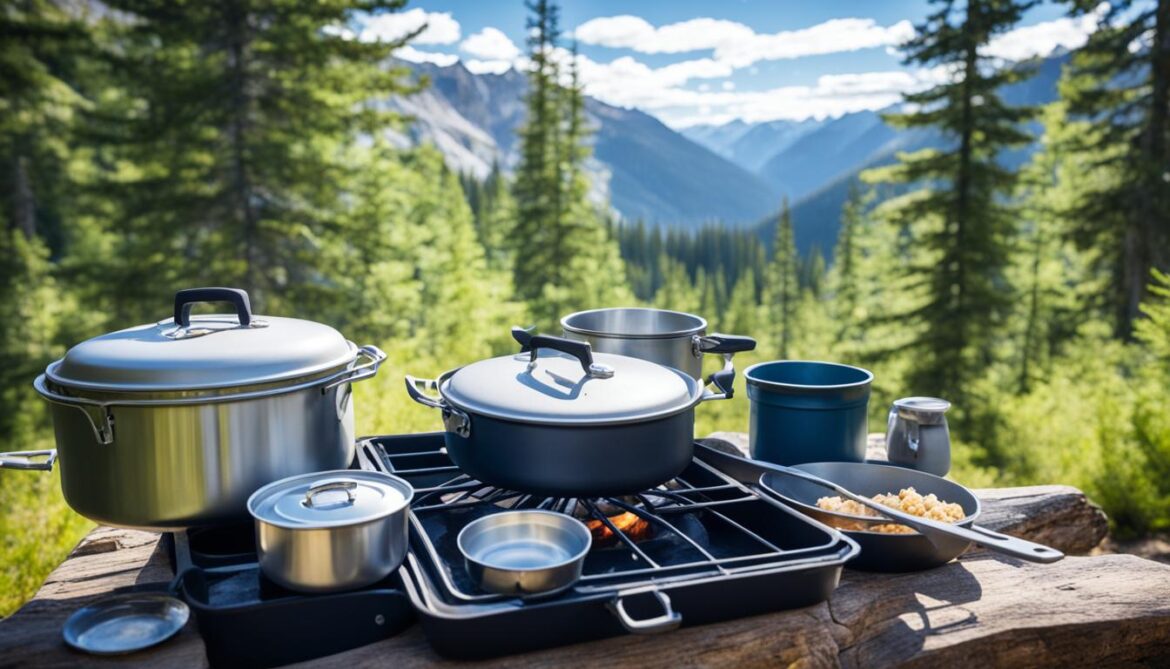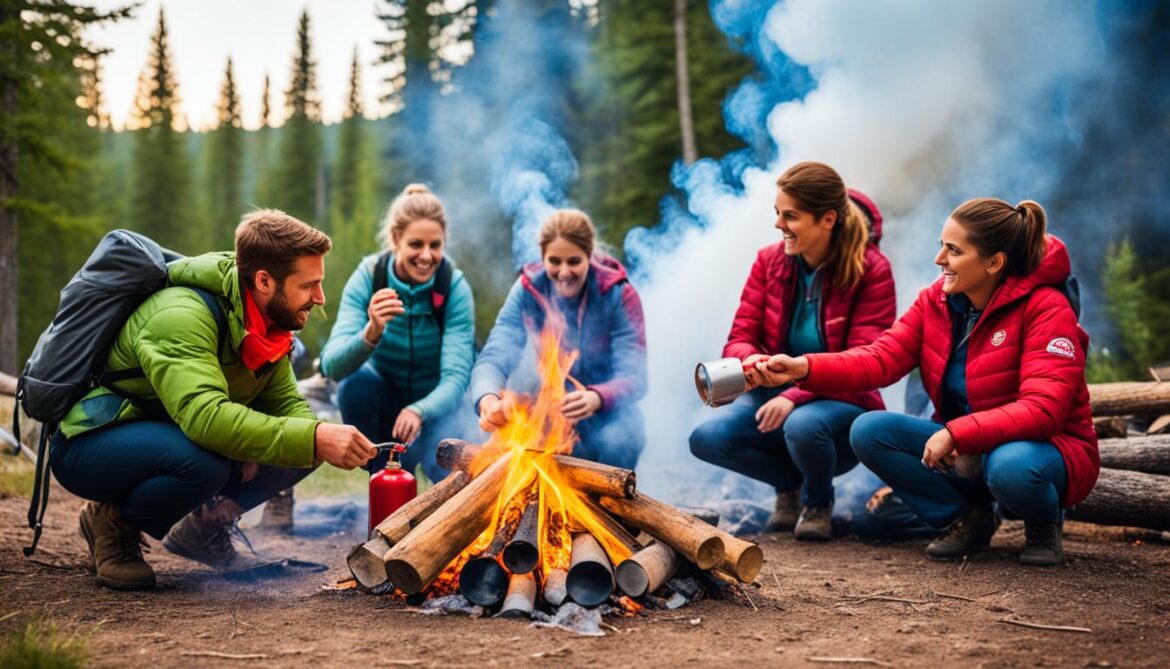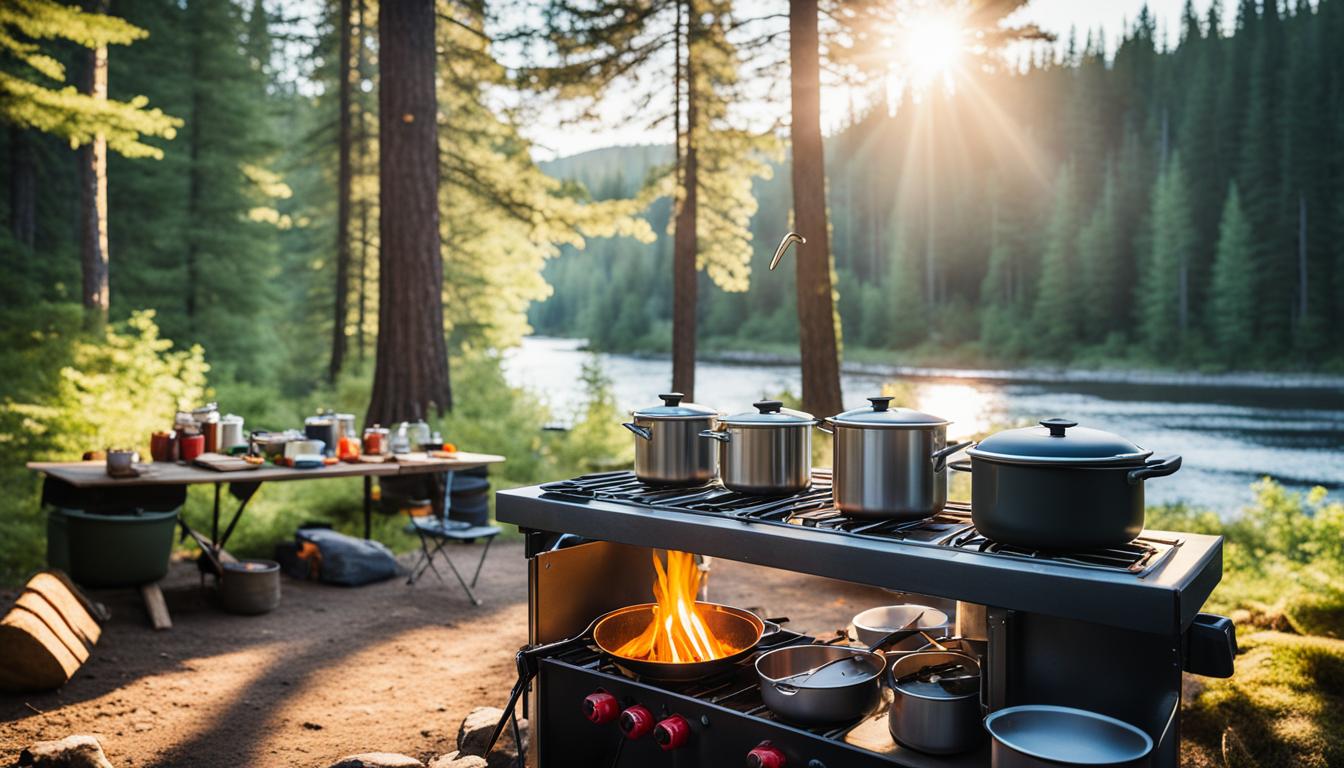Welcome to the world of outdoor cooking! If you’re planning a camping trip, one of the most important aspects to consider is your camp kitchen. A well-prepared camp kitchen can make your outdoor cooking experience efficient, enjoyable, and delicious. In this section, we’ll provide you with valuable tips on how to set up your camp kitchen efficiently and enjoy tasty campfire meals.
When it comes to outdoor cooking, being organized is key. By packing smart and having the essential camp kitchen items at hand, you’ll be able to create culinary masterpieces even in the wilderness. From selecting the right cooking gear to ensuring campfire safety, we’ll guide you through the process of setting up your camp kitchen like a pro.
But it’s not just about the setup; we’ll also share campfire cooking tips, mouthwatering recipe ideas, and outdoor cooking techniques to elevate your campfire meals. Whether you prefer traditional campfire classics or want to experiment with new flavors, we’ve got you covered.
So, get ready to pack smart, set up efficiently, and savor the taste of delicious campfire meals. Let’s dive into the world of outdoor cooking and unlock the secrets of a well-equipped camp kitchen!
Packing Smart for Your Camp Kitchen
When it comes to camp cooking, packing smart is essential to ensure you have everything you need while keeping your gear organized and compact. In this section, we’ll provide valuable tips and insights on how to pack smart for your camp kitchen, so you can have a hassle-free outdoor cooking experience.
Must-Have Camp Kitchen Essentials
Before you start packing, it’s important to have a clear understanding of the essential items you’ll need for your camp kitchen. Here are some must-have camp kitchen essentials:
- Cooking stove or grill
- Cookware set (pots, pans, and cooking utensils)
- Camp-friendly dishes, bowls, and cutlery
- Cooler or food storage containers
- Firestarter and matches
Having these essentials on hand will ensure you can cook delicious meals and enjoy your camping experience to the fullest.
Packing Tips for Your Camp Kitchen
Now that you know the essential items, let’s talk about how to pack them efficiently. Here are some useful packing tips for your camp kitchen:
- Use stackable containers or nesting cookware to save space.
- Place heavier items at the bottom of your pack to distribute weight evenly.
- Wrap fragile items, such as glass jars or bottles, in towels or clothes for added protection.
- Utilize storage compartments or pockets in your camping backpack or cooler for smaller items.
- Consider investing in collapsible cooking utensils and bowls to save space.
Selecting the Right Outdoor Cooking Gear
Choosing the right outdoor cooking gear is crucial for a successful camp kitchen setup. Here are some factors to consider when selecting your gear:
- Consider the type of outdoor cooking you’ll be doing. Will you be using a stove, grill, or open fire?
- Think about the size and weight of the gear. Is it lightweight and compact enough for easy transportation?
- Check the durability of the gear. Will it withstand the rigors of outdoor cooking?
- Read reviews and ratings to get insights from other campers and outdoor enthusiasts.
By keeping these factors in mind, you can choose the right outdoor cooking gear that suits your camping style and needs.
Effective Food Storage Solutions and Essential Cooking Utensils
Proper food storage is important for keeping your ingredients fresh and preventing any contamination. Consider using airtight containers or sealable bags for storing perishable items. It’s also crucial to pack essential cooking utensils such as spatulas, tongs, and knives that will facilitate your cooking process.
To help you visualize the packing process for your camp kitchen, here’s a sample diagram of a well-packed backpack:

With these packing tips and insights, you’ll be well-prepared to set up your camp kitchen and enjoy delicious meals in the great outdoors.
Setting Up Your Camp Kitchen
Setting up your camp kitchen is an essential part of any camping trip. Not only does it provide you with a convenient cooking space, but it also ensures campfire safety and efficient meal preparation. In this section, we will guide you through the process of creating a functional cooking station, while also emphasizing the importance of cleanup after cooking.
Ensuring campfire safety should be your top priority when setting up your camp kitchen. Always follow the campground or park regulations regarding campfires and cooking. Here are some general campfire safety tips to keep in mind:
- Choose a safe location for your campfire away from overhanging branches or flammable materials.
- Clear the area around the campfire from leaves, twigs, and other debris.
- Keep a bucket of water or a fire extinguisher nearby in case of emergencies.
- Never leave the campfire unattended, and always fully extinguish it before leaving or going to bed.
Once you have established a safe campfire, it’s time to set up your cooking station. A well-organized cooking station will make meal preparation much easier. Here are some tips to help you optimize your camp kitchen setup:
- Use a sturdy table or cooking surface to ensure stability and prevent accidents.
- Keep your cooking utensils, pots, and pans easily accessible for efficient meal preparation.
- Consider using a camp kitchen organizer or storage system to keep your cooking supplies neat and tidy.
- Use a portable sink or basin for washing dishes and utensils to maintain cleanliness.
Efficient meal preparation is essential for a successful camping trip. Here are some meal prep tips to make your camp cooking experience enjoyable:
- Plan your meals ahead of time and create a shopping list to ensure you have all the necessary ingredients.
- Prep ingredients, such as chopping vegetables or marinating meat, before your camping trip to save time at the campsite.
- Consider pre-cooking certain items, like rice or pasta, to simplify meal preparation at the campsite.
After enjoying a delicious campfire meal, it’s important to properly clean up your camp kitchen. This not only helps maintain hygiene but also ensures a safe cooking environment for future use. Here are some cleanup tips:
- Dispose of food waste in designated trash containers or use environmentally-friendly disposal methods, such as burying food scraps.
- Wash dishes and utensils with biodegradable soap and hot water. If available, use a portable sink or basin for easier washing.
- Properly store your cooking utensils and supplies, ensuring they are clean and dry, ready for the next use.

| Essential Camp Kitchen Setup Checklist |
|---|
| Campfire safety gear (fire extinguisher, bucket of water) |
| Sturdy table or cooking surface |
| Cooking utensils (spatula, tongs, knives) |
| Pots and pans |
| Camp kitchen organizer or storage system |
| Portable sink or basin for washing dishes |
Enjoying Delicious Campfire Meals
When it comes to camping, one of the highlights is undoubtedly the food. There’s something special about cooking and enjoying a meal in the great outdoors. In this section, we’ll provide you with valuable campfire cooking tips to elevate your culinary skills while camping.
First and foremost, it’s important to prepare and plan your meals in advance. Consider easy-to-make recipes that require minimal ingredients and equipment. Camping is all about simplicity, so opt for one-pot meals or foil packet recipes that can be cooked directly on the campfire. This not only saves time and effort but also reduces the number of dishes to clean up.
When it comes to outdoor cooking techniques, don’t be afraid to get creative. Experiment with grilling, Dutch oven cooking, or even using cast iron skillets. These methods can add depth and flavor to your meals, giving them that authentic campfire taste.
Lastly, for recipe ideas, think beyond the traditional hot dogs and s’mores. With a little planning, you can enjoy delicious and nutritious meals around the campfire. From hearty breakfast burritos to savory foil packet dinners and even satisfying desserts, the options are endless. Some popular choices include campfire chili, grilled vegetables, and stuffed campfire apples.
So, whether you’re new to outdoor cooking or a seasoned camper looking for fresh ideas, try incorporating these campfire cooking tips, exploring different techniques, and experimenting with new recipes. Let your taste buds savor the flavors of the great outdoors, creating memorable and tasty campfire meals on your next adventure.

